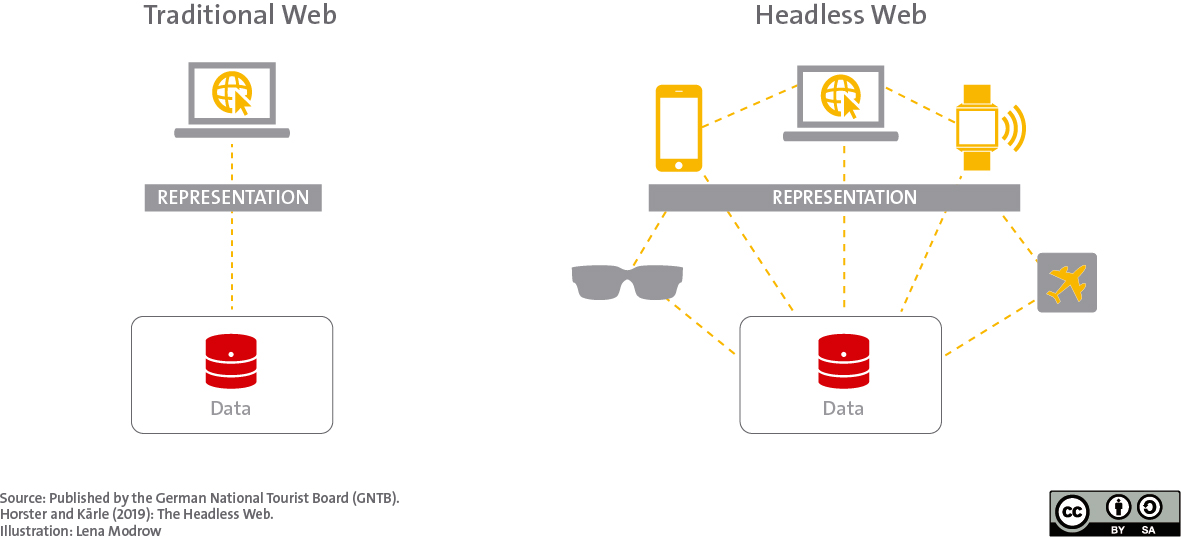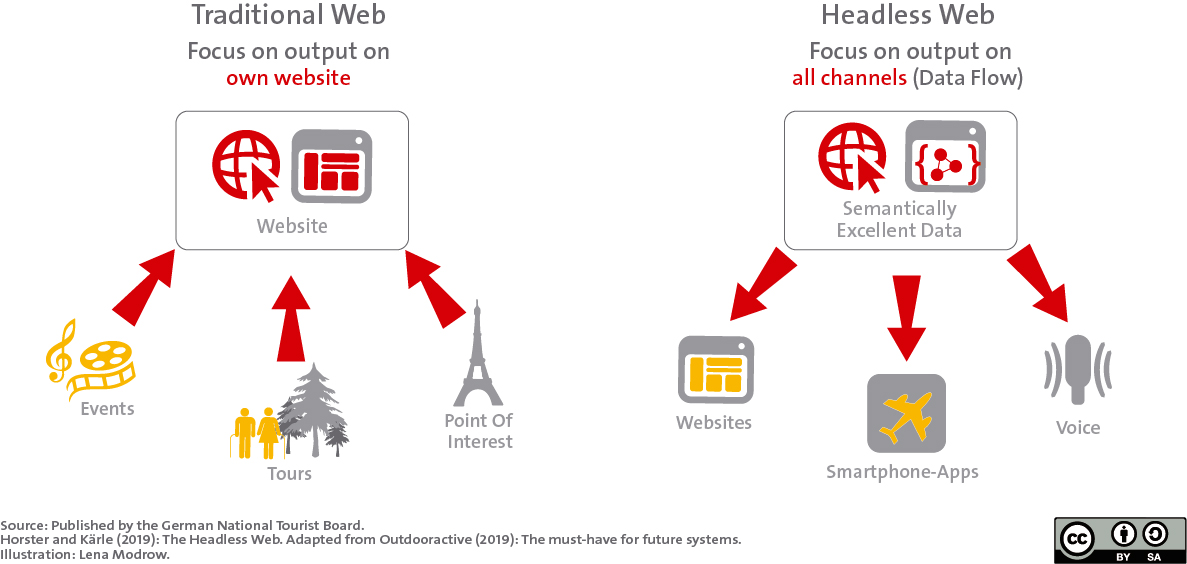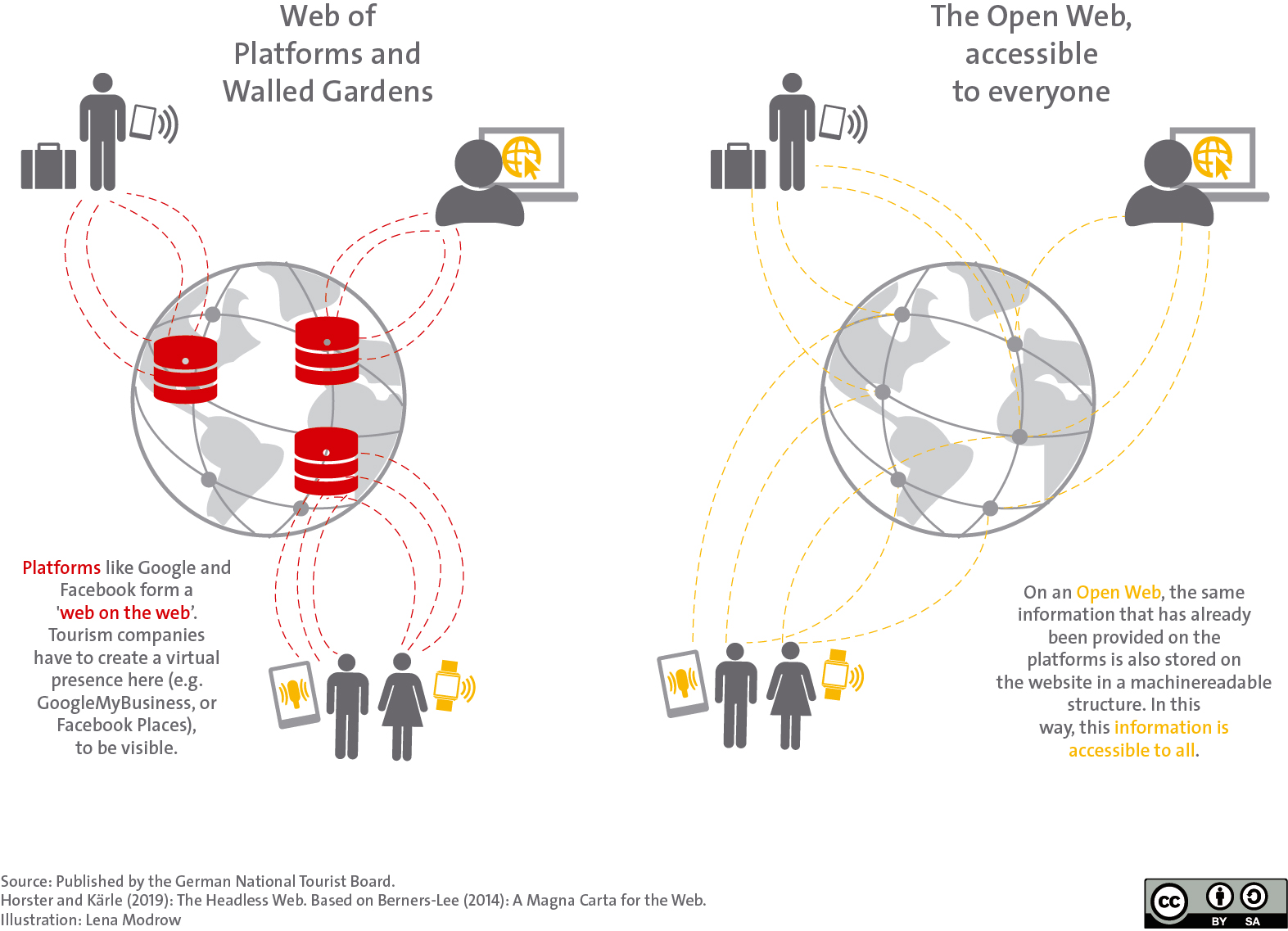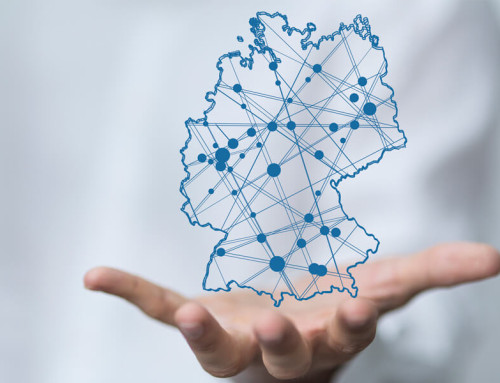Think data management modularly.
The Evolution of the Web.
The World Wide Web is undergoing a transformation process. The semantic web, also called Web 3.0, is currently developing, focusing on machine readability of data. The goal is for machines to independently establish meaningful connections. In this way, questions from users can be answered immediately. These developments are already changing the information behaviour of travellers.
In the near future, data sets will not only have to be displayed by machines, but also understood and interpreted: Guests ask specific questions and the answers are adapted and send to the respective output channel.
This means that identical information is displayed differently according to the guest’s provider and output device and their respective holiday situation – ideally in real time.
The fundamental change in this form of data processing is also known as the “headless web”. In this metaphor, the data is the body and the representation is the head. “Headless” now means that the body (i.e. the data) remains. The header – the representation of the data – is no longer determined by the creator of the content itself, as the output can take place on different channels and platforms.
According to the “old” logic of the web, data is imported into a database and then exported into another place (usually your own website). Following the new logic of the web, data does not necessarily have to be displayed graphically on a website.
It is important that they are readable and interpretable by machines so that they can be combined with others and displayed on a wide variety of output channels. For this purpose, data must be given a uniform semantic markup so that they are “interoperable” (see figure).
What does this mean for tourism stakeholders?
The classic web design will increasingly move into the background. The data architecture is rather crucial: The data must be correct, complete, up-to-date and described according to a common ontology (a markup language such as schema.org).
This would also allow a local output of data: information on restaurants could be extracted from websites of the respective catering establishments and displayed on digital display boards in the holiday resort. The visitors would then only be shown the gastronomy offer that is actually open.
Diners would not have to search restaurant websites or consult a search engine to do so.
Beyond the Walled Gardens
Big players like Google are currently (still) the drivers of the headless web. Google’s Knowledge Graph makes this clear: it provides answers to questions – without taking a detour to the website of the person offering the information. When searching for e.g. regional businesses such as restaurants or event venues, users increasingly receive an overview directly on the search results page.
Google also extracts this information directly from news, recipes or people and displays it adapted to the respective output medium. The websites on which this information is found are only listed thereafter. It’s a similar story for voice assistants. Here, too, answers are preferably read out directly instead of referring to a website, which the user would then have to search and read through himself. Information provided by voice assistants does not have a graphical interface, but an auditory one.
Large platforms are now increasingly building their own digital ecosystems, which concentrate attention with one provider (also called the economy of attention) and leads to a kind of web-on-web. All information can be found within the platform, so there is no need to leave it. In this context, one speaks of a “Walled Garden”, meaning an enclosed garden or a closed platform in which hardware and / or software components (operating systems, apps) are limited to one system.
All in all, these developments mean that information is increasingly being issued directly on the platforms. Depending on who extracts the information from which medium, a different form of output is subsequently produced. On the customer side, the advantage is obvious: you will find everything in one place and also uniformly processed. However, this is problematic for tourist operators such as hotel providers or restaurants.
They are becoming increasingly invisible in the digital space and their own company website is losing more and more relevance. As a result of these developments, small tourist businesses are finding it increasingly difficult to ensure the visibility of their own website on the net.
An Internet without such “walled gardens” would bring many benefits here. If data is made available in an open and semantically excellent way on websites, then it is not limited to just one platform, but could be made available to all.
It’s all on the website!
In order for local (tourist) businesses to remain visible on platforms such as Google or Facebook, they need to store as much information as possible in “virtual places” of platform operators such as Google My Business or Facebook Places, etc.
So if this data already has to be processed for these platforms, it can be made available to all other actors on the web in the same process. However, in order for them to be used by others, they should be semantically marked up with a de facto standard such as schema.org and made available as such on your own website.
The information should not be limited to company details. Events, POIs, hiking routes, availability, prices or recipes can also be published on the own website in a machine-readable way and thus be used by everyone. A common format to provide all this data is JSON-LD. In order to support tourism stakeholders in outputting the data in this format, there are generators that automatically describe the desired information with schema.org and provide it in a code snippet (a small and automatically generated program code) in the desired output format, which can then simply be inserted on the website.
Furthermore, this structured markup of data also helps with visibility within the major search engine providers, as it can be prominently displayed in the search results page. This is at least true for those data types listed in the Google Search Gallery. For example, business details of local operators (restaurants, hotels, leisure operators, etc.), events or reviews are touristically relevant.
Eric Horster
West Coast University of Applied Sciences
Eric Horster ist Professor an der Fachhochschule Westküste im Bachelor- und Masterstudiengang International Tourism Management (ITM) mit den Schwerpunktfächern Digitalisierung im Tourismus und Hospitality Management. Er ist Mitglied des Deutschen Instituts für Tourismusforschung.
Mehr zur Person unter: http://eric-horster.de/
Elias Kärle
University of Innsbruck
Elias Kärle ist Wissenschaftler an der Universität Innsbruck. In seiner Forschung beschäftigt er sich mit Knowledge Graphs, Linked Data und Ontologien. Als Vortragender referiert er meist zur Anwendung und Verbreitung semantischer Technologien im Tourismus.
Mehr zur Person unter: https://elias.kaerle.com/


















